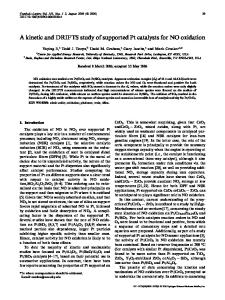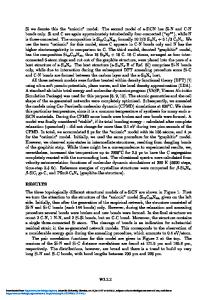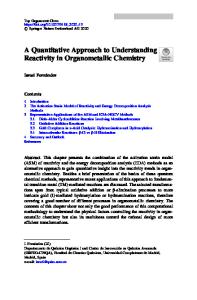A Kinetic Study of Hydrocarbons Reactivity on Palladium Catalysts through a DFT Approach
- PDF / 100,465 Bytes
- 6 Pages / 612 x 792 pts (letter) Page_size
- 11 Downloads / 289 Views
A Kinetic Study of Hydrocarbons Reactivity on Palladium Catalysts through a DFT Approach Valeria Bertani, Carlo Cavallotti, Maurizio Masi and Sergio Carrà Dipartimento di Chimica Fisica Applicata, Politecnico di Milano, Milano, ITALY ABSTRACT Palladium clusters have been chosen to represent a typical supported heterogeneous catalyst and their interaction with hydrocarbons has been investigated theoretically. The calculations were performed through density functional theory and the Becke-Lee-Yang-Parr hybrid (B3LYP) functional was adopted to calculate exchange and correlation energy. An effective core potential basis set (ECP on core electrons and Dunning/Huzinaga on outer electrons) was found sufficiently accurate to reproduce experimental data. Clusters containing up to seven Pd atoms were considered and their interaction with hydrogen, methane and ethane and their fragments was analyzed and a kinetic study of the system was performed. Transition states structures and energies were calculated through quantum mechanics and kinetic constants were derived from a statistic thermodynamic approach. On the basis of such information, a kinetic model that accounts for ethane transformations. Finally the kinetic scheme was embedded in a plug flow reactor model and simulations were performed to test the validity of the developed mechanism. In this way information obtained at the atomic scale were adopted to study phenomena occurring on the much higher reactor scale.
INTRODUCTION Heterogeneous catalysts, consisting of one or more metals highly dispersed on a support, are widely used in different fields of chemical industry; among them, palladium plays a leading role in particular for hydrocarbon hydrogenation and hydrocracking, due to its peculiar power to absorb hydrogen [1]. One of the key factors influencing the properties and performances of supported metal catalysts is the metal particle size, which is directly connected with the amount of active sites present on the catalytic surface. In fact, a variation in the dimension of the aggregates deposited on the support induces a change in number and coordination state, thus also in electronic configuration, of surface atoms. Thanks to the increase in computer speed, in these last years quantum chemistry calculations are more and more adopted in order to study properties and reactivity of catalysts, usually coupled with sophisticated characterization techniques and wide experimental campaign [2]. In this work, a theoretical study on isolated palladium clusters was conducted with the aim of investigating their reactivity with simple hydrocarbons. This simplification of course neglects the influence of the support, but it is an effective model for heterogeneous palladium catalysts, since the metal is usually present on support surface in the form of microaggregates, a state possessing intermediate properties between isolated atoms and the bulk solid. In particular, the identification of the most important elementary processes that take place when hydrogen or an hydrocarbon gas
Data Loading...











